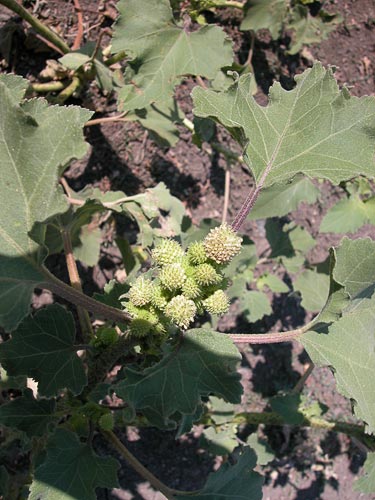Weeds
Xanthium strumarium L. - Common Cocklebur (Rough Cocklebur, Heartleaf Cocklebur)
Systematic position.
Family Asteraceae, genus Xanthium L.Biological group.
Annual late spring weed.Morphology and biology.
Stem is 15-120 cm tall, glaucous, straight, rigid, branchy, with short pubescence being glandular above. Leaves are petiolate, cordate, 3-5-lobed, coarse-tooth with unequal dents, with fine decumbent hairs and bristly pubescence on both sides. Flowers are yellow, located in special, almost spherical apical capitula. Corolla is true, tubular; stamens free. Involucre upon fruiting turns into dense ligneous prickly pericarp. Collective fruit ovoid, covered with hooked, spirally located thorns, oval. It usually contains two one-seeded fruits. Walls of collective fruit are very hard. Its apex has two large, strong, often unequal, and slightly bent thorns. A remarkable projection is developed at seed base. The surface is slightly transverse-rugose, covered with short fine hairs between thorns. Blossoming occurs in July-September. Maximum fruitfulness of one plant is 23,700 seeds. The temperature required for seed germination is +14-16°C at a minimum, +20-24°C at the optimum, +32-34°C at the maximum. Shoots appear in April-May; sometimes in June from depths of no more than 18-20 cm. Spreading of collective fruits takes place by attaching to animal fur.Distribution.
Europe, the Caucasus, Central Asia, Western Siberia, the Far East, Scandinavia, Atlantic Europe, Western and Eastern Mediterranean, the Balkan, Asia Minor, Iran, Afghanistan, India, Ceylon, Mongolia, China, Northern America, Northern Africa.Ecology.
This heat-loving and drought-resistant plant grows among habitations, along roads, on waste grounds, dumps, along ditches and river banks, and in crops.Economic significance.
This is a weed plant in crops of cotton, soya, maize, sunflower, vegetable cultures, perennial grasses, in kitchen gardens. Control measures include stubbling, autumn plowing, cleaning of sowing material, pre-seeding treatment of ground, inter-row treatments; if necessary, application of herbicides; maintenance of crop rotation; cutting the weed before flowering.Reference citations:
Chepelev R.D. 1977. Weeds of Amur Region. Blagoveshchensk: Khabarovsk Publishing House. 72 p. (In Russian)Sal.nikova A.F., Zakharkin F.G. 1953. Main weed plants in the Far East and their control. Khabarovsk: Khabarovsk Publishing House. 56 p. (In Russian)
Zakharenko V.A., Zakharenko A.V. 2004. Weed control. Zashchita i karantin rastenii, 4: 62-142. (In Russian)


